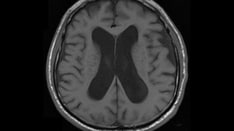Background
Aseptic meningitis is an illness characterized by serous inflammation of the linings of the brain (i.e., meninges), usually with an accompanying mononuclear pleocytosis. Clinical manifestations vary, with headache and fever predominating. The illness is usually mild and runs its course without treatment; however, some cases can be severe and life threatening.
Aseptic meningitis syndrome is not caused by pyogenic bacteria. Although it is usually caused by certain viruses, it has a number of other etiologies as well, both infectious and noninfectious. Hence, the term aseptic meningitis is no longer synonymous with viral meningitis, although the two are still often used interchangeably.
The epidemiologic setting (e.g., time of year, geographic locale, exposure to insects, diseases prevalent in the local community) and accompanying systemic manifestations may be helpful in making a presumptive diagnosis. However, with a few exceptions, the clinical and laboratory findings accompanying acute viral meningitis are insufficiently distinct to allow an etiologic diagnosis, and distinguishing these disorders from a number of nonviral diseases may be difficult.
Treatment varies with the cause. No specific pharmacologic treatment is available for most cases of viral meningitis; these patients are managed with supportive therapy, which includes analgesics, antinausea medications, intravenous fluids, and prevention and treatment of complications.
Viral infection
Overall, viral infection is the most common form of aseptic meningitis, and enteroviruses are the most common viral cause. Enteroviruses are small, nonenveloped RNA viruses of the picornavirus family with various serotypes. More than 50 subtypes have been linked with meningitis. Coxsackieviruses and echoviruses, which are enteroviruses, account for approximately half of cases of aseptic meningitis.
Certain enteroviruses (e.g., coxsackievirus B5, echovirus 6, 9, and 30) are more likely to cause meningitis outbreaks, while others (coxsackie A9, B3, and B4) are mostly endemic. [1, 2, 3] The incidence of infections from enteroviruses increases in the summer and early fall. Transmission occurs by hand-to-mouth contact and to a lesser extent by respiratory and fecal routes.
Herpesviruses, both herpes labialis (HSV-1) and genital herpes (HSV-2), can cause meningitis in children and especially infants. Varicella-zoster virus, another herpesvirus, causes encephalitis but only in immunocompromised persons.
Mumps was a common cause of aseptic meningitis in the United States until mumps vaccination came into use. In several countries, mumps virus remains a common pathogen in aseptic meningitis. It is spread by respiratory secretions, with increased incidence in the spring.
Aseptic meningitis from HIV occurs mostly at the time of seroconversion. HIV spreads to the meninges hematogenously, while rabies, polio, and herpesviruses are neurotrophic (i.e., spread through neurons).
Aseptic meningitis from arboviruses follows geographic and seasonal patterns determined by the life cycle of arthropod vectors, animal reservoirs, and their contact with human subjects. Eastern equine encephalitis virus (EEEV) usually is observed in Atlantic and Gulf regions, whereas western equine encephalitis virus (WEEV) is prevalent in the western part of the United States. WEEV is responsible for more aseptic meningitis cases than EEEV.
Approximately 15% of St Louis encephalitis virus (SLEV) infections result in meningitis. In children, this incidence is as high as 60%. SLEV infection can occur in both rural and urban areas. In the rural setting, the infection from SLEV tends to follow the same pattern as WEEV infection. Conversely, in urban settings, outbreaks tend to be more explosive.
Approximately 18% of people infected with Colorado tick fever develop meningitis. This disease primarily occurs in the Rocky Mountain region, which is the habitat of Dermacentor andersoni ticks whose bite transmits the virus.
Infection with Venezuelan equine encephalitis virus initially leads to influenza-like illness in most people. Only 3% of infected persons are known to develop acute meningitis. This virus has spread into Florida and some southwestern states. LCMV, an arenavirus, is an extremely rare cause of meningitis. Transmission of LCMV infection occurs by contact with dust or food contaminated by excreta of rodents. Cases tend to be more common in the winter. Human infections have been seen in both laboratory and home settings.
Brucellosis
Brucellosis is an infection with a bacterium of one of the Brucella species, usually Brucella abortus (cattle), Brucella melitensis, Brucella ovis (sheep, goats), Brucella suis (pigs), or rarely Brucella canis (dogs). Its distribution is worldwide, but it is most common in the Mediterranean regions, Africa, the Middle East, India, Central Asia, Mexico, and Central and South America.
Persons at highest risk of brucellosis are those who work with animals that are infected, such as veterinarians and ranchers, and persons who consume raw milk or cheeses made with raw milk. Brucellosis also may be transmitted to humans if they are exposed inadvertently to live brucellosis vaccine by a needlestick or other accident.
The incidence in the United States is fewer than 0.5 cases per 100,000 population.
Drug-induced aseptic meningitis
The incidence of drug-induced meningitis (DIAM) is unknown. Many antimicrobials can cause the disorder (e.g., trimethoprim-sulfamethoxazole, ciprofloxacin, cephalexin, metronidazole, amoxicillin, penicillin, isoniazid). Other drugs that have been associated with DIAM include NSAIDs, ranitidine, carbamazepine, vaccines against hepatitis B and mumps, immunoglobulins, radiographic agents, and muromonab-CD3.
DIAM may recur with re-exposure to the offending agent. Green et al reported a case of lamotrigine-induced aseptic meningitis, with a second episode on rechallenge with lamotrigine. [5]
The pathogenic mechanisms of DIAM are diverse and presumably differ from drug to drug. There are two proposed mechanisms: direct meningeal irritation by the intrathecal drug and hypersensitivity reactions to the drug (type III and IV). In type III hypersensitivity reactions, the drug or its metabolite forms a complex with antibodies in the serum, in turn activating the complement cascade. In type IV reactions, T helper cells, after previous sensitization, are recruited to the site of inflammation. [6]
DIAM from muromonab (OKT3) is believed to be mediated, at least in part, by cytokine release. Why such reactions are confined selectively to the CSF compartment is unclear.
Aseptic meningitis—along with cerebral vasospasm or ischemic encephalopathy—has been reported with intravenous immunoglobulin (IVIg) therapy. [7] Jarius et al strongly suggest that in vivo activation of TNF-alpha–primed neutrophils by atypical antineutrophil cytoplasmic antibodies (ANCAs) of IVIg may contribute to these side effects. [8]
Aseptic meningitis in systemic disease
Patients with systemic lupus erythematosus are especially susceptible to aseptic meningitis. In these patients, the disorder is often precipitated by drugs.
Vogt-Koyanagi-Harada syndrome
The exact etiology of this condition remains uncertain. Originally, the Vogt-Koyanagi syndrome was described independently of the Harada syndrome. However, the clinical manifestations of both overlap sufficiently to justify their combination into a single entity.
Behçet syndrome
The cause of Behçet syndrome remains uncertain. CNS manifestations occur in 18% of patients with Behçet syndrome.
Mollaret meningitis
Mollaret meningitis is a recurrent disorder whose causative agent remains unknown. However, recent data suggest that herpes simplex virus (HSV-2 and, less frequently, HSV-1) may cause some if not most cases.
Iatrogenic aseptic meningitis
Patients have developed febrile meningeal syndromes shortly after undergoing embolization of cerebral aneurysms with hydrogel-coated coils. [9]
Postoperative aseptic meningitis was first described by Cushing in 1925, [10] though the mechanisms remain unclear.
Go to Meningitis, Meningococcal Meningitis, Staphylococcal Meningitis, Haemophilus Meningitis, Viral Meningitis, and Tuberculous Meningitis for more complete information on these topics.
Etiology
Aseptic meningitis may be caused by viruses, bacteria, fungi, parasites, drugs, systemic diseases, and miscellaneous other conditions.
Viral causes include the following:
-
Enteroviruses - coxsackievirus, echovirus, poliovirus
-
Herpes simplex virus (HSV) types 1 and 2 (HSV-1, HSV-2)
-
Varicella-zoster virus
-
Arboviruses
-
Epstein-Barr virus
-
HIV
-
Influenza virus types A and B
-
Mumps virus
-
Coloradotick fever virus
-
Lymphocytic choriomeningitis virus (LCMV)
-
Rabies
Bacterial causes are as follows:
-
Partially treated bacterial meningitis
-
Parameningeal infection
-
Endocarditis
-
Mycoplasma pneumoniae
-
Mycobacterium tuberculosis
-
Ehrlichiosis - monocytic, granulocytic
-
Borrelia burgdorferi
-
Treponema pallidum
-
Brucella species
Fungal causes are as follows:
-
Cryptococcus neoformans
-
Histoplasma capsulatum
-
Coccidioides immitis
-
Blastomyces dermatitides
Parasites that can cause aseptic meningitis are as follows:
-
Toxoplasma gondii
-
Taenia solium (cysticercosis)
Drugs that can cause aseptic meningitis include the following:
-
Nonsteroidal anti-inflammatory drugs (NSAIDs)
-
Antimicrobials (e.g., trimethoprim-sulfamethoxazole, amoxicillin, isoniazid)
-
Muromonab-CD3 (Orthoclone OKT3)
-
Azathioprine
-
Intravenous immunoglobulin
-
Intrathecal methotrexate
-
Intrathecal cystine arabinoside
-
Vaccines
-
Allopurinol
Systemic diseases that can cause aseptic meningitis include the following:
-
Sarcoidosis
-
Leptomeningeal cancer
-
Posttransplantation lymphoproliferative disorder
-
Systemic lupus erythematosus
-
Wegener granulomatosis
-
CNS vasculitis
-
Behçet disease
-
Vogt-Koyanagi-Harada syndrome
Miscellaneous causes include the following:
-
Arachnoiditis
-
Migraine
-
Postinfectious syndromes
Epidemiology
Frequency
Viral meningitis is a relatively common disorder. In Olmsted County, Minnesota, the incidence of viral meningitis was 10.9 per 100,000 person-years from 1950 to 1981, with most cases occurring in the summer months. [4] The incidence of aseptic meningitis has been reported as 11 per 100,000 person-years, compared with a rate of 8.6 per 100,000 for bacterial meningitis. In the United States, a specific cause is usually identifiable in 10-15% of cases of meningitis.
Prognosis
Aseptic meningitis is usually a benign disease. Rates of morbidity and mortality are low, except among neonates. Most patients experience full recovery in 5-14 days after onset of symptoms. Fatigue, light-headedness, and asthenia may persist for months in some cases, however.
Complications
Seizures sometimes can complicate meningitis. Encephalitis may develop in some patients. The most common sequela following mumps meningoencephalitis is sensorineural deafness. Hydrocephalus from aqueductal stenosis has been reported as a late sequela of mumps meningitis and encephalitis in children.







